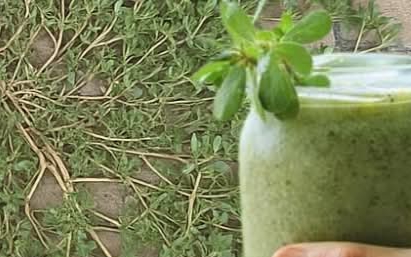What is Purslane?Purslane is a low-growing succulent plant that thrives in many climates around the world. Its leaves and stems are entirely edible, and its taste has a pleasant lemony hint due to its high malic acid content. Traditionally, it has been consumed fresh in salads, cooked in soups, or used as a garnish.Although it often grows wild in gardens, sidewalks, and fields, purslane is far from being just a pesky weed—it’s a superfood packed with essential nutrients.Nutritional Profile of PurslanePurslane stands out for its unique combination of vitamins, minerals, and beneficial plant compounds. Just 100 grams of fresh purslane contains:Omega-3 fatty acids – especially alpha-linolenic acid (ALA), rare for a plant source.Vitamin A – supports eye health and immune function.Vitamin C – boosts immunity and aids collagen production.Vitamin E – protects cells from oxidative damage.Magnesium, Calcium, and Potassium – essential for heart and muscle health.Iron – supports red blood cell production.Antioxidants – such as betalains, which combat inflammation and oxidative stress.Health Benefits of Purslane1. Supports Heart HealthPurslane is rich in plant-based omega-3s, which can help reduce triglyceride levels, support healthy cholesterol balance, and promote overall cardiovascular wellness.2. Anti-Inflammatory PropertiesThanks to its omega-3s and antioxidant compounds, purslane can help reduce inflammation in the body, benefiting people with arthritis, joint pain, or other inflammatory conditions.3. Improves Eye HealthIts high vitamin A and beta-carotene content supports vision, helps prevent night blindness, and may reduce the risk of age-related macular degeneration.4. Boosts ImmunityWith vitamins C and E, purslane strengthens the immune system, helping the body fight off infections and illnesses.5. Aids in Weight ManagementLow in calories but high in nutrients, purslane is an excellent addition to a weight-loss diet. Its fiber content helps keep you full longer and supports healthy digestion.6. Promotes Healthy SkinAntioxidants and vitamin A in purslane help improve skin elasticity, reduce wrinkles, and protect against damage from UV exposure.7. Supports Bone HealthMagnesium, calcium, and phosphorus in purslane contribute to strong bones and may help prevent osteoporosis.How to Use PurslanePurslane is incredibly versatile in the kitchen:Salads: Mix fresh purslane leaves with tomatoes, cucumbers, and olive oil for a refreshing summer salad.Soups & Stews: Add chopped purslane near the end of cooking for extra nutrition and flavor.Smoothies: Blend fresh leaves with fruits for an omega-3-rich green smoothie.Pickled Purslane: Preserve the leaves in vinegar, garlic, and spices for a tangy condiment.Traditional & Folk UsesIn traditional herbal medicine, purslane has been used to:Cool the body during feverRelieve stomach discomfortTreat skin irritations and wounds when applied as a poulticeSupport urinary tract healthPrecautionsWhile purslane is safe for most people, those prone to kidney stones should consume it in moderation due to its oxalate content. Always wash fresh purslane thoroughly before eating.Final ThoughtsPurslane proves that sometimes the most valuable foods are right under our feet—literally. Packed with omega-3s, antioxidants, vitamins, and minerals, this humble plant offers exceptional health benefits and delicious culinary potential. Whether you forage it from your garden or buy it at a local market, adding purslane to your diet is a smart and nutritious choice.
Purslane: A Nutrient-Rich Plant with Numerous Benefits
